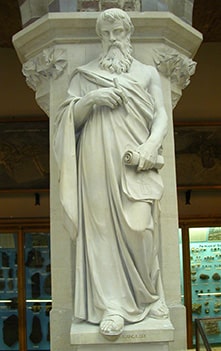Pythagorean triples
Pythagorean triples consists of three positive integers a, b, and c, such that a2 + b2 = c2. These triples are commonly written as (a, b, c), and a typical example is (3, 4, 5); 32 + 42 = 52 or 9 + 16 = 25.
A primitive Pythagorean triple is one in which a, b and c are coprime (gcd(a, b, c) = 1) and for any primitive Pythagorean triple, (ka, kb, kc) for any positive integer k is a non-primitive Pythagorean triple.
Euclid's formula (300 BC) will generate Pythagorean triples given an arbitrary pair of positive integers m and n with m > n > 0. A primitive Pythagorean triple additionally require:
- m and n have opposite parity – i.e. if one is odd, the other must be even.
- m and n are coprime – i.e. they have no common integer factors greater than 1.
It's easy to check algebraically that the sum of the squares of the first two is the same as the square of the last one.
Below is a table of [a, b, c] for n between 1 and 9 and m between 2 and 10.
The highlighted cells show primitive Pythagorean triples (GCD(a, b, c) = 1).
| n = | 1 | 2 | 3 | 4 | 5 | 6 | 7 | 8 | 9 |
|---|
| m ↓ |
| 2 | [3,4,5] |
| 3 | [8,6,10] | [5,12,13] |
| 4 | [15,8,17] | [12,16,20] | [7,24,25] |
| 5 | [24,10,26] | [21,20,29] | [16,30,34] | [9,40,41] |
| 6 | [35,12,37] | [32,24,40] | [27,36,45] | [20,48,52] | [11,60,61] |
| 7 | [48,14,50] | [45,28,53] | [40,42,58] | [33,56,65] | [24,70,74] | [13,84,85] |
| 8 | [63,16,65] | [60,32,68] | [55,48,73] | [48,64,80] | [39,80,89] | [28,96,100] | [15,112,113] |
| 9 | [80,18,82] | [77,36,85] | [72,54,90] | [65,72,97] | [56,90,106] | [45,108,117] | [32,126,130] | [17,144,145] |
| 10 | [99,20,101] | [96,40,104] | [91,60,109] | [84,80,116] | [75,100,125] | [64,120,136] | [51,140,149] | [36,160,164] | [19,180,181] |
 Euclid of Alexandria was one of the most prominent mathematicians of antiquity best known for his treatise on mathematics, The Elements.
Euclid of Alexandria was one of the most prominent mathematicians of antiquity best known for his treatise on mathematics, The Elements.
 Euclid of Alexandria was one of the most prominent mathematicians of antiquity best known for his treatise on mathematics, The Elements.
Euclid of Alexandria was one of the most prominent mathematicians of antiquity best known for his treatise on mathematics, The Elements.